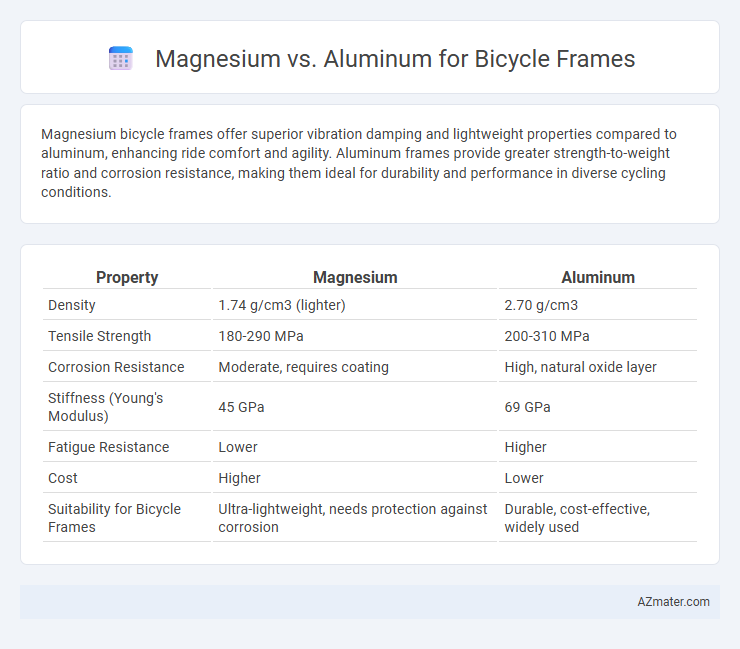Magnesium bicycle frames offer superior vibration damping and lightweight properties compared to aluminum, enhancing ride comfort and agility. Aluminum frames provide greater strength-to-weight ratio and corrosion resistance, making them ideal for durability and performance in diverse cycling conditions.
Table of Comparison
| Property | Magnesium | Aluminum |
|---|---|---|
| Density | 1.74 g/cm3 (lighter) | 2.70 g/cm3 |
| Tensile Strength | 180-290 MPa | 200-310 MPa |
| Corrosion Resistance | Moderate, requires coating | High, natural oxide layer |
| Stiffness (Young's Modulus) | 45 GPa | 69 GPa |
| Fatigue Resistance | Lower | Higher |
| Cost | Higher | Lower |
| Suitability for Bicycle Frames | Ultra-lightweight, needs protection against corrosion | Durable, cost-effective, widely used |
Introduction: Magnesium vs Aluminum Bicycle Frames
Magnesium bicycle frames offer exceptional lightweight properties, weighing about 33% less than aluminum, which enhances climbing and acceleration performance. Aluminum frames provide superior corrosion resistance and greater stiffness, making them ideal for riders seeking durability and efficient power transfer. Both materials present distinct advantages in frame design, balancing weight, strength, and ride quality for varying cycling needs.
Material Properties: Magnesium and Aluminum Compared
Magnesium offers a lower density of approximately 1.74 g/cm3 compared to aluminum's 2.70 g/cm3, resulting in lighter bicycle frames which improve ride agility and acceleration. Aluminum provides higher tensile strength, typically around 310 MPa, surpassing magnesium's average of 220 MPa, offering better resistance to stress and deformation under load. While magnesium has superior vibration damping properties, reducing rider fatigue, aluminum excels in corrosion resistance and ease of fabrication, influencing longevity and maintenance considerations for bicycle frames.
Weight Differences and Impact on Cycling
Magnesium bicycle frames are typically lighter than aluminum frames, with magnesium alloys offering a density of about 1.7-1.9 g/cm3 compared to aluminum's 2.7 g/cm3, resulting in significant weight savings that enhance climbing efficiency and acceleration. The reduced weight of magnesium frames lowers the overall bicycle mass, improving rider endurance and responsiveness, especially during extended rides and rapid maneuvers. Despite aluminum's widespread use due to its strength and corrosion resistance, magnesium's superior strength-to-weight ratio makes it a preferred choice for performance-focused cyclists seeking optimal weight reduction.
Strength and Durability Factors
Magnesium frames offer a high strength-to-weight ratio but generally have lower fatigue resistance compared to aluminum, making aluminum more durable under repetitive stress conditions. Aluminum frames exhibit excellent corrosion resistance and maintain structural integrity over prolonged use, while magnesium requires protective coatings to prevent degradation. For riders prioritizing long-term durability and strength, aluminum frames typically provide enhanced performance and longevity.
Ride Quality and Vibration Absorption
Magnesium bicycle frames offer superior vibration absorption compared to aluminum, resulting in a smoother ride quality on rough terrain. The natural damping properties of magnesium reduce road buzz and fatigue, enhancing rider comfort over long distances. Aluminum frames, while lightweight and stiff, tend to transmit more vibrations, which can lead to a harsher ride perception.
Corrosion Resistance and Maintenance
Magnesium bicycle frames offer good corrosion resistance when treated with protective coatings like anodizing or powder coating, but bare magnesium is highly susceptible to corrosion, especially in wet or salty environments. Aluminum frames naturally form a thin oxide layer that provides excellent corrosion resistance, requiring minimal maintenance over time. Regular cleaning and occasional application of anti-corrosion sprays ensure both materials maintain longevity, but aluminum frames generally demand less upkeep compared to magnesium.
Manufacturing Costs and Availability
Magnesium bicycle frames have higher manufacturing costs due to complex casting processes and limited industrial infrastructure, making them less available compared to aluminum frames. Aluminum frames benefit from widespread availability of raw materials and established production methods like extrusion and welding, resulting in lower costs and more abundant supply. The affordability and accessibility of aluminum make it the preferred choice for mass-produced bicycle frames, while magnesium is often reserved for niche applications despite its lightweight properties.
Performance in Various Cycling Conditions
Magnesium bicycle frames offer superior vibration damping and lightweight properties, enhancing rider comfort and control in rough terrain and long-distance rides. Aluminum frames provide greater stiffness and durability, making them ideal for sprinting and aggressive riding styles on smooth roads. Both materials perform well under different cycling conditions, with magnesium excelling in shock absorption and aluminum delivering power transfer efficiency.
Environmental Impact of Magnesium vs Aluminum
Magnesium bicycle frames have a lower carbon footprint than aluminum due to the metal's abundance and energy-efficient extraction processes, reducing greenhouse gas emissions during production. Recycling magnesium requires significantly less energy compared to aluminum, further minimizing environmental impact and supporting sustainability in the cycling industry. However, aluminum's widespread recycling infrastructure and longer service life help offset some environmental concerns, making both metals viable yet distinct choices for eco-conscious cyclists.
Which Frame Material is Best for You?
Magnesium frames offer a lightweight and comfortable ride with excellent vibration damping, making them ideal for long-distance cyclists seeking fatigue reduction. Aluminum frames provide superior stiffness and durability at a lower cost, favored by riders focused on speed and aggressive handling. Choosing between magnesium and aluminum depends on whether you prioritize ride comfort and weight savings or frame rigidity and budget considerations.

Infographic: Magnesium vs Aluminum for Bicycle Frame
 azmater.com
azmater.com